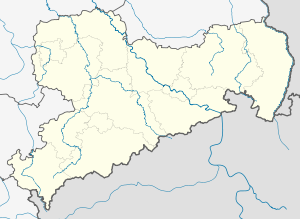Göltzschtalbrücke (A 72)
Coordinates: 50 ° 34 ′ 50 ″ N , 12 ° 18 ′ 11 ″ E
|
|
||
|---|---|---|
| use | Highway bridge | |
| Convicted | Federal motorway 72 | |
| Crossing of | Göltzsch | |
| place | White sand | |
| overall length | 364 m | |
| Number of openings | 5 | |
| Pillar spacing | 62 m | |
| Clear width | 50.5 m | |
| height | 35 m | |
| completion | 1938 | |
| location | ||
|
|
||
The Göltzschtalbrücke spans the Göltzsch valley near Weißensand, a district of Lengenfeld , and crosses the federal highway 72 . It stands between the Treuen and Reichenbach junctions and was built during the construction of the Vogtland motorway. The structure is located about ten kilometers south of the famous Göltzschtalbrücke railway overpass and is one of a number of bridges in the Vogtland that span either the White Elster or the Göltzsch valley.
history
The bridge was built from October 1937 to December 1938. A four-lane motorway bridge was planned and built . Due to the Second World War (labor and material shortages), the motorway route was only completed with two lanes, so that only two lanes were created on the bridge. In April 1945 the bridge was blown up by retreating German soldiers. The restoration of the bridge and the two-lane Vogtland motorway took place during the time of the Soviet occupation zone (SBZ) and ended in October 1948. In the GDR , the Weißensander bridge, like the rest of the Vogtland motorway south of Zwickau , was not expanded to four lanes. On the one hand, this was due to the fact that the unfinished Elstertal Bridge stood in front of the border with the Federal Republic of Germany . On the other hand, the volume of traffic towards West Germany was generally low, which is why the GDR government failed to create the two missing lanes on the Weißensander Bridge. During the GDR era, the bridge could therefore also be crossed by pedestrians. In reunified Germany , the A 72 and with it the Göltzschtal bridge became more important again. The bridge was therefore fundamentally renovated and widened from 1992 to 1994 and now has two hard shoulders in addition to the four lanes.
construction
The Göltzschtalbrücke has a length of 364 m. As with most of the large bridges on the Vogtland motorway, an arched structure made of natural stone masonry was chosen. Inside, the stones are embedded in backfill concrete, which was built in layers as tamped concrete . The maximum 35 m high bridge has five arches with pillar spacings of 62 m and clear widths of 50.5 m.
The renovation in the early 1990s was intended to change the appearance of the bridge as little as possible. A prestressed concrete bridge with twelve fields was built into the old structure between the granite side walls. As a superstructure for each directional carriageway, this has a single-cell, consistently high hollow box made of prestressed concrete , which on one side has a widely cantilevered carriageway plate. The production took place with standard support widths of 31 m using the incremental launching method . New grouting piles in the pillars are supported by prestressed balance beams as substructures , on which the superstructure is in turn supported. For the installation of the new bridge construction, the old backfill concrete was milled out as far as necessary and statically possible.
literature
- Jürgen Stritzke: Stone bridges . In: Gerhard Mehlhorn (Ed.): Handbook bridges. Springer-Verlag, Berlin, Heidelberg 2007, p. 312, ISBN 978-3-540-29659-1 .
Web links
Individual evidence
- ↑ Road construction report 1993/94, p. 57 (PDF; 2.6 MB)

